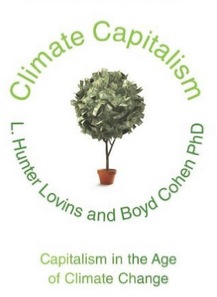Book of the Week: Climate Capitalism
I just finished reading Climate Capitalism, a book that presents the opportunities afforded by entrepreneurial solutions to achieving a low-carbon economy. I particularly appreciate that the authors addressed the importance of small businesses, as “the economic engine of any country, in North America generating more than half of non-farm private gross domestic product.” They support this claim with familiar figures courtesy of the U.S. Small Business Administration: small businesses represent 99.7 per cent of all employer firms, employing nearly 60 million workers, or about half of all private-sector employees. In the past decade alone, small businesses have created 60 to 80 per cent of net new jobs each year. The authors recognize the importance of small businesses in efforts to reduce our carbon footprint in writing (page 39) that small businesses “confront correspondingly promising opportunities and bear significant responsibility for global sustainability.” But small businesses generally lack the resources to hire chief sustainability officers or undertake the measures pursued by Fortune-500 companies to address climate change.
Fortunately, the authors present pragmatic ways small businesses can contribute to global solutions for climate sustainability. They write (page 39) “Energy efficiency remains one of the best investments that a small business owner can make.” They cite examples of small businesses that reduced their energy bills by two-thirds employing such simple measures as replacing incandescent lights with compact fluorescent bulbs or holding meetings in rooms lit by natural light. They also show how the use of power strips prevents appliances from consuming electricity even when they are switched off, a wasteful practice known as “phantom load”. I was stunned to read that Americans spend more money supplying electrical powers to DVD players when they are turned off than when they are actually in use. The authors demonstrate how small businesses implementing weatherization programs (such as caulking windows and sealing leaky ducts) have realized a 40 per cent return on their investments. Programmable thermostats typically return 30 per cent in annual savings. This book presents practical steps small businesses can take to achieve a sustainable environment and I highly recommend it.
